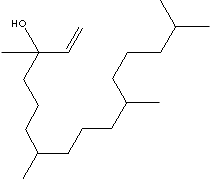PRODUCT IDENTIFICATION

H.S. CODE
TOXICITY
CLASSIFICATION
PHYSICAL AND CHEMICAL PROPERTIES
AUTOIGNITION
NFPA RATINGS
REFRACTIVE INDEX
1.457
175 C
GENERAL DESCRIPTION & APPLICATIONS
APPEARANCE
96.0% max
EXTERNAL LINKS
Chemical synthesis. : Total chemical synthesis of isophytol may start from the addition of acetylene (CAS 74–86–2) to acetone (67–64–1) resulting in 3-methyl-1-butyn-3-ol (115–19–5), which is hydrated in the presence of a palladium catalyst to 3-methyl-1-buten-3-ol (115–18–4), which is reacted with either diketene or acetic acid ester to the acetoacetate and the latter thermally reacted to 2-methyl-2-hepten-6-one (110–93–0). Alternatively, 3-methyl-1-buten-3-ol is reacted with isopropenyl methyl ether (116–11–0) to 2-methyl-2-hepten-6-one. In a third synthetic pathway, isoprene hydrochloride is reacted with acetone in the presence of an alkaline condensating agent or in the presence of organic bases as catalysts to 2-methyl-2-hepten-6-one. 2-Methyl-2-hepten-6-one is then reacted with acetylene to dehydrolinalool (29171–20–8), to which isopropenyl methyl ether is added to make pseudoionone (141–10–6). The three double bonds are hydrated to form 6,10-dimethyl-2-undecanone (1604–34–8), which is reacted with acetylene to 3,7,11-trimethyl-1-dodecyn-3-ol (1604–35–9). Isopropenyl methyl ether is added to form 6,10-14-trimethyl-4,5-pentadecadiene-2-one (16647–10–2), which is hydrated to hexahydrofarnesyl acetone (502–69–2). This is again reacted with acetylene to 3,7,11,15-tetramethyl-1-hexadecyn-3-ol (dehydroisophytol, 29171–23–1), which is finally hydrated to isophytol. The repeated addition of acetylene and hydration was first described by Fischer and Löwenberg [1929].
Natural origins.: Isophytol has been reported from several (at least 15) species of flowering plants and from two red algae [various authors, see IUCLID p. 11/133 “Additional Remarks”]. This broad systematic distribution suggests that isophytol is a common compound in plant biochemistry that may have a long evolutionary history. However, no high concentrations have been reported nor is detection truly wide-spread, in contrast to other terpenoid alcohols. The Merck Index [1999] states that isophytol is a "decomposition product of chlorophyll", which would make it a very common substance. However, no literature has been located that would support this statement in the broadly general form used. There is not one single clear identification of isophytol as either a precursor or direct metabolite of chlorophyll; in contrast, the isomer phytol, having the hydroxy group in terminal position, has been shown to be both a precursor and direct metabolite of chlorophyll (and other compounds). On the other hand, for both anaerobic and aerobic, freshwater and marine sediments there is good experimental evidence for abiotic isomerisation of phytol to isophytol [Brooks and Maxwell, 1974; de Leeuw et al., 1977; Didyk etal., 1978; Rontani et al., 1999]. Brooks and Maxwell [1974] commented about this isomerisation of phytol to isophytol through "allylic rearrangement of the hydroxyl function occurring readily" in the context of sediments, probably needing certain clay mineral surfaces for the transformation [deLeeuw et al., 1977]. Further, de Leeuw et al. also showed that this abiotic isophytol is only an early, relatively short-lived intermediate in the diagenetic conversion of chlorophyll-derived phytol to, eventually, kerogen, an insoluble, high-molecular-weight organic constituent of sedimentary (http://www.chem.unep.ch/irptc/)
PRICE INFORMATION